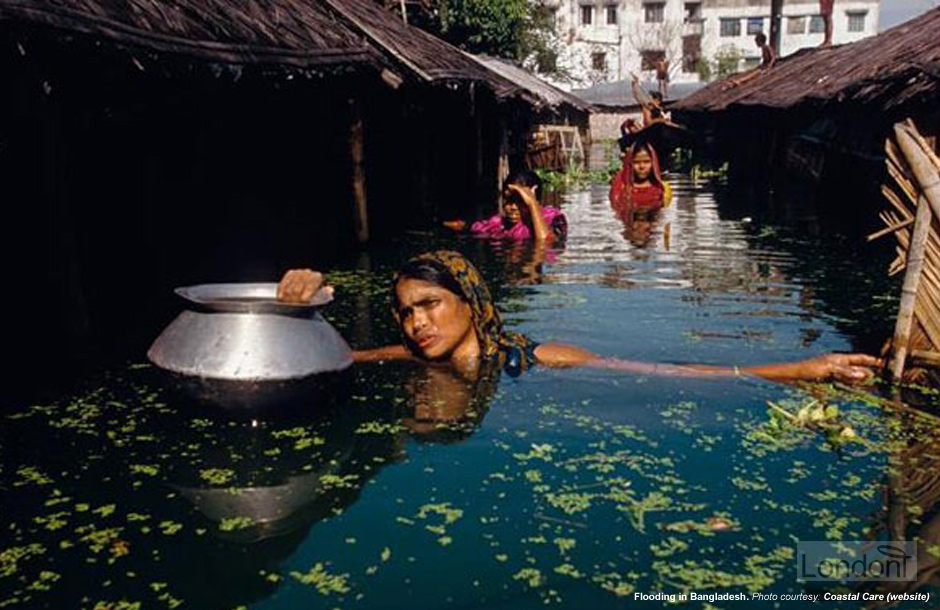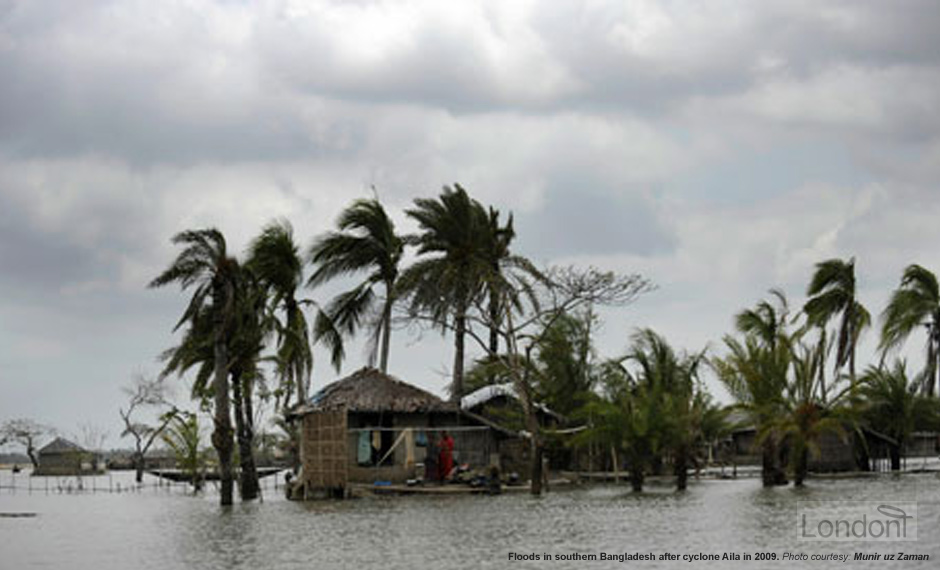
Devastating summer floods of 1970
On 2 August 1970, East Pakistan was severely struck by monsoon floods covering 15,000 square miles and affecting 30 million people, nearly half of the province's population. The mighty Ganges and Brahmaputra rivers burst their banks causing vast areas of the low lying province to be under water. Rapidly rising floodwater brought death and destruction and local people were forced to evacuate their homes in boats and makeshift rafts. In Dhaka, the province capital with a population of 750,000, river waters entered the streets, flooding houses in many parts of the city.
Damage to staple food crops and property was officially estimated at 215 million rupees (about £19 million) and 341,000 acres of Jute and rice lands had been badly damaged. The country's rice deficit for the year was expected to exceed 1.43 million tons.
Damage to infrastructure was also severe. At the height of the flooding, Dhaka was completely cut off by road and rail from northern districts. Rail traffic between Dhaka and Narayanganj had all but ceased, with tracks 6ft (nearly 2m) under water in many places.
The Pakistani Army was called in to plan emergency relief organisation. Pakistan air force planes flew in about 45 tons of supplies which were distributed by army helicopters to camps housing thousands of people evacuated from stricken areas. The helicopters dropped supplies of rice and medicine in the worst hit areas whilst speedboats were also used to ferry relief supplies.
In many places, rescue teams discovered survivors marooned on rooftops and railway embankments - the only high ground in the vicinity. At the height of the flooding, Dacca, the province capital with a population of 750,000, was completely cut off by road and rail from northern districts.
At least 100 people were estimated to have died.
President Yahya visits flood hit areas two days later
Two days after the flooding, on 4 August 1970, President Yahya flew into Dhaka to inspect the major flood damage personally. He drove, walked and waded round Dhaka and visited the Sarafatganj community centre, to see for himself the vaccination campaign being carried on there. The President also visited two relief camps in the city, and the severely flooded areas of Mohammadpur, Gandaria, and Sadarghat.
Yahya walked all the camps primarily located in the local schools and temporary shelters. He distributed clothes, blankets, wheat, rice, and other ready-made food items. Yahya became a popular figure outright to the poor people. Everyone chanted 'Yahya Zindabad'. Days later a cross section of the same people chanted anti-Yahya slogan when Mujib launched campaign meetings at various parts of Dhaka city including other districts that were inundated with flood water.
Genocide Bangladesh website
Flood water took another three weeks to subside. When people returned to their home shortly thereafter, many of them found no food at home, no job, wrecked houses, and their life was turned upside down.
Election postponed for two months
Due to the unprecedented flood situation in East Pakistan, the election dates were changed. After an emergency cabinet meeting in Dhaka on 8 August 1970 the President postponed the general election scheduled for 5 October 1970 by two months because of the seriousness of the flood situation. Thus, on the pretext that East Pakistan needed time to recover from the natural disaster, the government announced that the election to the National Assembly would be held on 7 December 1970 while the Provincial elections on 19 December 1970.
The President summoned Saturday's [8 August 1970] Cabinet meeting as both Dacca and the nearby jute centre of Narayanganj were threatened with further flooding and the Ganges and the Sitalakhyia rivers rose another six inches (15 CM).
Many mills on the banks of the rivers are already partly flooded, and any further rise in the waters will close many of them.
The December dates were viewed as the most appropriate time as it was not ideal to hold elections in November since the Muslim fasting month of Ramadhan began on 2 November 1970 and people would have shorter working days. Almost all political parties and members favored the justification except for Sheikh Mujibur Rahman and Zulfikar Ali Bhutto. /p>
Bhashani was against voting as he proclaimed 'Voter aagey baat chai' (We want food before election). Therefore, Bhashani suggested for complete abandonment of the election again by getting the chance of flooding.
It was Mujib who never recognized the problems of flooding in the then Eastern Pakistan. He wanted the election to be conducted by hook or by crook at the earliest possible time. Many interpreters seeing Mujib’s adamant attitude commented that Mujib may lose popularity as time runs out. This is because Mujib may become untrustworthy to the people if too long time is taken to conduct election. That is why Mujib was very restless and never acknowledge about flooding as a severe problem. He was the person who told flood is not an issue of changing the date for election but a great conspiracy is being hatched by other leaders of Pakistan who do not like his party to secure people’s mandate to get power in the center (Islamabad).

Cyclone frequency increases prior to 1970 Great Bhola Cyclone
High tidal waves and tropical storm surges constantly strike the north-west shores of the Bay of Bengal around the deltas of the Ganges and Brahmaputra rivers. The one that struck on 9 November 1970 surpassed all the others in terms of fatalities. It was the 9th severe cyclone to strike East Pakistan in 10 years and the worst tropical cyclone disaster in history.
| Dates | Main location | Description | Lives lost & damages |
|---|---|---|---|
| 16 Oct 1942 | Southwest coast | 15 foot (5m) storm surge | 40,000 |
| 2 June 1956 | Barisal | ferry driven ashore near the river town of Barisal | 199 and 20,000 left homeless |
| Oct 1960 | Islands of Ramgati and Hatia | 20 ft (7m) high storm surge | drowned at least 5,000 people |
| 28 May 1963 | Near Comilla | cyclone came ashore | 22,000 killed, three times as much left homeless |
| 11-12 may 1965 | Noakhali district | cyclones | Drowned 30,000 people |
| June 1965 | Barisal district | cyclone | 10,000 killed |
| 21 Dec 1965 | cyclone | 10,000 killed |
Following two previously destructive cyclones in October 1960 which killed at least 16,000 people in East Pakistan, the Pakistani government contacted the American government for assistance in developing a system to avert future disasters. Gordon Dunn, the director of the National Hurricane Center at the time, carried out a detailed study and submitted his report in 1961. However, the government did not carry out all of the recommendations Dunn had listed.
 Gordon Dunn ()
Gordon Dunn ()
The coast of the Bay of Bengal is particularly vulnerable to the effects of tropical cyclones. The 1970 Bhola cyclone was not the most powerful of these, however; the 1991 Gorky Cyclone was significantly stronger when it made landfall in the same general area with 160 mph (250 km/h) winds, a high-end Category 4.
The Great Bhola cyclone, which struck the Ganges River delta on 13 November 1970, was by no means the strongest cyclone ever recorded. Far stronger tropical cyclones raged through the Pacific Ocean during the same year, and the Great Bhola cyclone was not necessarily even the strongest storm of the 1970 North Indian Ocean cyclone season. What made the Bhola cyclone "Great" was not the force of nature, but the force of circumstances: simply put, the Bhola cyclone struck in the worst possible place at the worst possible time.
Why do people continue to move to cyclone prone areas?
The delta regions of Bangladesh are the most fertile land in the country. The same yearly sediment deposits that create the char islands also bring rich alluvial soil deposits to the region, allowing high crop yields with minimal effort and basic agricultural practices. Farmers can expect to yield three rice crops per year, making them attractive place to live despite the risk of storm surges.
Another reason why people go to storm-prone region is that there's no room in other parts of densely populated nation. In 1970, East Pakistan had 75 million people crowded in an area the size of Arkansas, USA - which holds only three million. The population of present day Bangladesh is over 160 million and rising.
Unfortunately, as is common in an agricultural region where birth control is rare, the region's high fertility rate has historically led, not to high incomes, but rather to a large and impoverished population. At the time of the Great Bhola Cyclone, the Ganges River Delta boasted a population density of nearly 400 people per square kilometer, rivaling the modern-day Netherlands, one of Europe's most densely populated states.
Overall, Bangladesh's population jumped by about 17 million between 1961 and 1971, an increase of over 30%. To accommodate this swelling population, delta farmers pushed more and more to the south, clearing land for farms in the Sunderban forest, a vast expanse of coastal mangroves which used to act as a buffer against storm surges.
